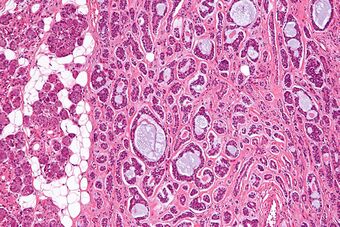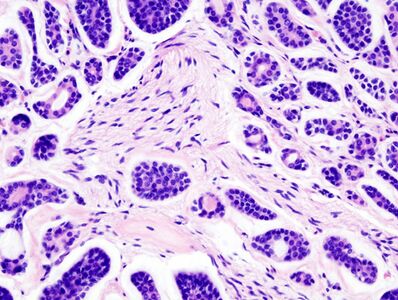Medicine:Adenoid cystic carcinoma
| Adenoid cystic carcinoma | |
|---|---|
| Other names | Adenocyst, Malignant cylindroma, Adenocystic, Adenoidcystic |
 | |
| Micrograph of an adenoid cystic carcinoma of a salivary gland (right of image): Normal serous glands, typical of the parotid gland, are also seen (left of image), H&E stain. | |
Adenoid cystic carcinoma is a rare type of cancer that can exist in many different body sites. This tumor most often occurs in the salivary glands, but it can also be found in many anatomic sites, including the breast,[1][2] lacrimal gland, lung, brain, Bartholin gland, trachea, and the paranasal sinuses.
It is the third-most common malignant salivary gland tumor overall (after mucoepidermoid carcinoma and polymorphous adenocarcinoma). It represents 28% of malignant submandibular gland tumors, making it the single most common malignant salivary gland tumor in this region. Patients may survive for years with metastases because this tumor is generally well-differentiated and slow growing. In a 1999 study[3] of a cohort of 160 ACC patients, disease-specific survival was 89% at 5 years, but only 40% at 15 years,[citation needed] reflecting deaths from late-occurring metastatic disease.
Cause
Activation of the oncogenic transcription factor gene MYB is the key genomic event of ACC and seen in the vast majority of cases.[4][5] Most commonly, MYB is activated through gene fusion with the transcription factor encoding NFIB gene as a result of a t(6;9) translocation.[4] Alternatively, MYB is activated by copy number gain or by juxtaposition of enhancer elements in the vicinity of the MYB gene.[6] In a subset of ACCs, the closely related MYBL1 gene is fused to NFIB or to other fusion partners.[7][8]
MYB drives proliferation of ACC cells and regulates genes involved in cell cycle control, DNA replication and repair, and RNA processing.[9] Thus, the MYB oncogene is a potential diagnostic and therapeutic target in ACC.
ACC has a relatively quiet genome with few recurrent copy number alterations or point mutations,[6][10][11][12] consistent with the view that MYB and MYBL1 are the main oncogenic drivers of the disease.
Treatment
Primary treatment for this cancer, regardless of body site, is surgical removal with clean margins. This surgery can prove challenging in the head and neck region due to this tumor's tendency to show a perineural discontinuous growth, meaning that it follows nerves and different "nests" of the tumor can exist without a connection to the original tumor. Therefore, MRI-images should be analysed following nerve tracts up to the brainstem. Adjuvant or palliative radiotherapy is commonly given following surgery. For advanced major and minor salivary gland tumors that are inoperable, recurrent, or exhibit gross residual disease after surgery, fast neutron therapy is widely regarded as the most effective form of treatment.[13][14][15][16] Chemotherapy is used for metastatic disease. Chemotherapy is considered on a case-by-case basis, as data on the positive effects of chemotherapy are limited. Clinical studies are ongoing, however.[citation needed]
Images
-
Coronal MRI showing right parotid adenoid cystic carcinoma with perineural spread of tumor: The tumor originates in the right parotid gland and spreads along the trigeminal nerve via the auricuotemporal branch extending intracranially through the foramen ovale at the skull base towards Meckel's cave.
-
Coronal MRI showing right parotid adenoid cystic carcinoma with perineural spread of tumor along the facial nerve extending to the stylomastoid foramen
-
Histopathological image of adenoid cystic carcinoma of the salivary gland infiltrating a nerve (center), H&E stain
-
Histopathological image of adenoid cystic carcinoma of the salivary gland, immunostain for S-100 protein
-
Micrograph of adenoid cystic carcinoma, fine needle aspiration specimen, Pap stain
-
Adenoid cystic carcinoma with comedonecrosis
-
Relative incidence of submandibular tumors, with adenoid cystic carcinoma being the second most common.[17]
-
Relative incidence of parotid tumors, with adenoid cystic carcinoma being relatively rare.[17]
See also
- Primary cutaneous adenoid cystic carcinoma
- Collagenous spherulosis
References
- ↑ "Adenoid cystic carcinomas of the breast and salivary glands (or 'The strange case of Dr Jekyll and Mr Hyde' of exocrine gland carcinomas)". J Clin Pathol 63 (3): 220–8. Mar 2010. doi:10.1136/jcp.2009.073908. PMID 20203221.
- ↑ "The birth of an adenoid cystic carcinoma". Int J Surg Pathol 23 (1): 26–7. Feb 2015. doi:10.1177/1066896914548795. PMID 25185745. https://scholarworks.iupui.edu/bitstream/1805/7652/1/fusco-2015-the-birth.pdf.
- ↑ Fordice, Jim; Kershaw, Corey; El-Naggar, Adel; Goepfert, Helmuth (February 1999). "Adenoid Cystic Carcinoma of the Head and Neck: Predictors of Morbidity and Mortality". Archives of Otolaryngology–Head & Neck Surgery 125 (2): 149–52. doi:10.1001/archotol.125.2.149. PMID 10037280.
- ↑ 4.0 4.1 "Recurrent fusion of MYB and NFIB transcription factor genes in carcinomas of the breast and head and neck". Proc Natl Acad Sci U S A 106 (44): 18740–4. 2009. doi:10.1073/pnas.0909114106. PMID 19841262. Bibcode: 2009PNAS..10618740P.
- ↑ "The landscape of gene fusions and somatic mutations in salivary gland neoplasms - Implications for diagnosis and therapy". Oral Oncol 57: 63–9. 2016. doi:10.1016/j.oraloncology.2016.04.002. PMID 27101980.
- ↑ 6.0 6.1 "Clinically significant copy number alterations and complex rearrangements of MYB and NFIB in head and neck adenoid cystic carcinoma". Genes Chromosomes Cancer 51 (8): 805–17. 2012. doi:10.1002/gcc.21965. PMID 22505352.
- ↑ "Recurrent Fusions in MYB and MYBL1 Define a Common, Transcription Factor-Driven Oncogenic Pathway in Salivary Gland Adenoid Cystic Carcinoma". Cancer Discov 622 (2): 176–87. 2016. doi:10.1158/2159-8290.CD-15-0859. PMID 26631070.
- ↑ "Novel MYBL1 Gene Rearrangements with Recurrent MYBL1-NFIB Fusions in Salivary Adenoid Cystic Carcinomas Lacking t(6;9) Translocations". Clin Cancer Res 22 (3): 725–33. 2016. doi:10.1158/1078-0432.CCR-15-2867-T. PMID 26631609.
- ↑ "Targeting the Oncogenic Transcriptional Regulator MYB in Adenoid Cystic Carcinoma by Inhibition of IGF1R/AKT Signaling". J Natl Cancer Inst 109 (9). 2017. doi:10.1093/jnci/djx017. PMID 28954282.
- ↑ "The mutational landscape of adenoid cystic carcinoma". Nat Genet 45 (7): 791–8. 2013. doi:10.1038/ng.2643. PMID 23685749.
- ↑ "Whole exome sequencing of adenoid cystic carcinoma". J Clin Invest 123 (7): 2965–8. 2013. doi:10.1172/JCI67201. PMID 23778141.
- ↑ "Whole-Genome Sequencing of Salivary Gland Adenoid Cystic Carcinoma". Cancer Prev Res (Phila) 9 (4): 265–74. 2013. doi:10.1158/1940-6207.CAPR-15-0316. PMID 26862087.
- ↑ Laramore, GE (September 1987). "Fast neutron radiotherapy for inoperable salivary gland tumors: is it the treatment of choice?". International Journal of Radiation Oncology, Biology, Physics 13 (9): 1421–3. doi:10.1016/0360-3016(87)90240-9. PMID 3114190.
- ↑ "Ten years of fast neutron therapy in Münster". Bulletin du Cancer. Radiothérapie 83 (Suppl): 115s–21s. 1996. doi:10.1016/0924-4212(96)84895-x. PMID 8949762.
- ↑ Douglas, James G; Laramore, George E; Austin-Seymour, Mary; Koh, Wui-jin; Stelzer, Keith; Griffin, Thomas W (February 2000). "Treatment of locally advanced adenoid cystic carcinoma of the head and neck with neutron radiotherapy". International Journal of Radiation Oncology, Biology, Physics 46 (3): 551–7. doi:10.1016/S0360-3016(99)00445-9. PMID 10701733.
- ↑ "Utilisation des neutrons rapides dans le traitement des tumeurs des glandes salivaires : rationnel, revue de la littérature et expérience d'Orléans" (in French). Cancer/Radiothérapie 4 (3): 181–90. 2000. doi:10.1016/S1278-3218(00)89092-7. PMID 10897760.
- ↑ 17.0 17.1 "Salivary Gland Neoplasms". 23 December 2021. https://emedicine.medscape.com/article/852373-overview. Updated: Jan 13, 2021
Diagrams by Mikael Häggström, MD
Further reading
- Neville, Damm, Allen, Bouquot. Oral and Maxillofacial Pathology. 2nd edition.
External links
- [1] Search for clinical trials at ClinicalTrials.gov
- [2] Search for research literature at PubMed.gov
- [3] Search for consumer health information at Medlineplus.gov
| Classification |
|---|
 |






![Relative incidence of submandibular tumors, with adenoid cystic carcinoma being the second most common.[17]](/wiki/images/thumb/a/a7/Relative_incidence_of_submandibular_tumors.png/960px-Relative_incidence_of_submandibular_tumors.png)
![Relative incidence of parotid tumors, with adenoid cystic carcinoma being relatively rare.[17]](/wiki/images/thumb/b/b1/Relative_incidence_of_parotid_tumors.png/960px-Relative_incidence_of_parotid_tumors.png)

